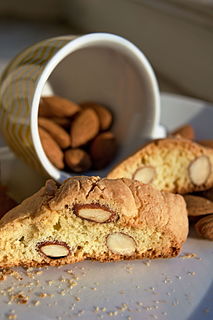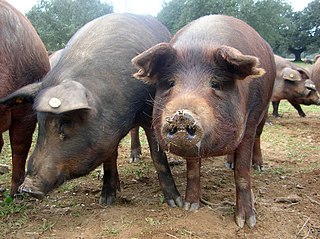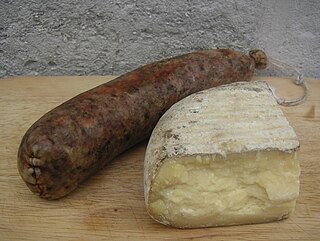


Occitan cuisine is the traditional cuisine and gastronomy of Occitania, [1] the supranational region where Occitan is traditionally spoken.



Occitan cuisine is the traditional cuisine and gastronomy of Occitania, [1] the supranational region where Occitan is traditionally spoken.
Occitan cuisine is a kind of Mediterranean cuisine, very close to Catalan cuisine in the west and to Italian cuisine in the east. This is due not only to the great breadth of Occitania, which goes from the Atlantic Ocean, to the South of France and to the Mediterranean Sea, but to its great geographic diversity as well, the latter whereof grants Occitan cuisine many different kinds of ingredients and dishes adapted to differing localities.[ example needed ]
As with other Mediterranean cuisines, it has basic ingredients with strong flavors, such as garlic, olives, salted fish, olive oil and wine, but it also shares some characteristics with Atlantic cuisines, such as the use of cheese and butter. Some of its specialties are well known around the Mediterranean, where they exist in exactly the same form, otherwise with little variation — for example, bolhabaissa, [2] alhòli, [3] ratatolha, [2] and pan golçat (bread with garlic), with emphasis on fines herbes. Other specialties include caçolet, [4] pastís de treflas, [5] aligòt, [5] farcidures (potato and meat dumpling), [5] freginat (fricassee of pork), [6] clafotís, flaunharda, and garbure.

Spanish cuisine consists of the cooking traditions and practices from Spain. Olive oil is heavily used in Spanish cuisine. It forms the base of many vegetable sauces. Herbs most commonly used include parsley, oregano, rosemary and thyme. The use of garlic has been noted as "common to all Spanish cooking." The most used meats in Spanish cuisine include chicken, pork, lamb and veal. Fish and seafood are also consumed on a regular basis.

Aioli, allioli or aïoli is a cold sauce consisting of an emulsion of garlic and olive oil; it is found in the cuisines of the northwest Mediterranean, from Andalusia to Calabria.

Pa amb tomàquet, is a traditional food of Catalan, Aragonese and Balearic cuisine. Pa amb tomàquet is considered a staple of Catalan cuisine and identity. While considered a signature toast dish in the Catalan Countries, it is common in bars throughout the rest of Spain, where it is also known as pan tumaca.

Catalan cuisine is the cuisine from Catalonia. It may also refer to the shared cuisine of Northern Catalonia and Andorra, the second of which has a similar cuisine to that of the neighbouring Alt Urgell and Cerdanya comarques and which is often referred to as "Catalan mountain cuisine". It is considered a part of western Mediterranean cuisine.

Bouillabaisse is a traditional Provençal fish stew originating in the port city of Marseille. The French and English form bouillabaisse comes from the Provençal Occitan word bolhabaissa, a compound that consists of the two verbs bolhir and abaissar.

Occitania is the historical region in Western and Southern Europe where Occitan was historically the main language spoken, and where it is sometimes still used, often as a second language. This cultural area roughly encompasses the southern third of France, as well as part of Spain, Monaco, and smaller parts of Italy. Occitania has been recognized as a linguistic and cultural concept since the Middle Ages, but has never been a legal nor a political entity under this name. However, the territory was united in Roman times as the Seven Provinces and in the Early Middle Ages.

Mediterranean cuisine is the food and methods of preparation used by the people of the Mediterranean Basin. The idea of a Mediterranean cuisine originates with the cookery writer Elizabeth David's book, A Book of Mediterranean Food (1950) and was amplified by other writers working in English.

Biscotti, known also as cantucci, are Italian almond biscuits that originated in the Tuscan city of Prato. They are twice-baked, oblong-shaped, dry, crunchy, and may be dipped in a drink, traditionally Vin Santo.

Valencian cuisine is a Mediterranean cuisine as cooked in the Valencian Community, Spain. Its basic ingredients are vegetables, seafood and meat. It is famous worldwide for its rices, such as paella, and its citrus fruits. The cuisine of neighbouring regions have given and received important contributions from Valencian gastronomy, amongst them Balearic cuisine, Catalan cuisine, Aragonese cuisine, Manchego cuisine and Murcian cuisine.
The regional cuisines of medieval Europe were the results of differences in climate, seasonal food variations, political administration and religious customs that varied across the continent. Though sweeping generalizations should be avoided, more or less distinct areas where certain foodstuffs dominated can be discerned. In the British Isles, northern France, the Low Countries, the northern German-speaking areas, Scandinavia and the Baltic the climate was generally too harsh for the cultivation of grapes and olives. In the south, wine was the common drink for both rich and poor alike while beer was the commoner's drink in the north and wine an expensive import. Citrus fruits and pomegranates were common around the Mediterranean. Dried figs and dates occurred quite frequently in the north, but were used rather sparingly in cooking.

Arroz a la valenciana or Valencian rice is a name for a multitude of rice dishes from diverse cuisines of the world, which originate from the rice-cooking tradition of the Valencian Community, in eastern Spain.

Extremadura, Spain is known for its different ways of preparing the Iberian pork and mutton. The main characteristics of the traditional Extremaduran cuisine were its simplicity, its lack of clutter and its low cost. It is also a cuisine reflecting a generous spirit, for many of its preparations used to be cooked in large pots to share with visitors, friends, and neighbors. The resulting dishes are eaten with local bread.
Jaime Fábrega Colón is a Spanish gastronomy writer, journalist, historian and professor at some universities. He has written more than fifty gastronomy and cooking books, he has won five times the Gourmand World Cookbook Award and he has made Ferran Adrià known over the world as a Catalan chef. He takes part of some international cultural associations as for example AICA and FIJET.

Picada is one of the characteristic sauces and culinary techniques essential to Catalan cuisine. The technique is typically found in Catalonia and Valencia and subsequently Catalan cuisine and Valencian cuisine. It is not an autonomous sauce like mayonnaise or romesco, but it is added as a seasoning during the cooking of a recipe.

Flaó is a cheesecake or tart found in Spanish cuisine popular from Catalan speaking areas. It is claimed by Majorca, Ibiza and Formentera, with some controversy. Traditionally flaons were part of Easter family celebrations in Menorca, but now they are available all year round.

Faire chabrot or faire chabròl is an ancient Occitanian custom whereby at the end of a soup or broth, one adds red wine to the bowl to dilute the remnants and brings it to the lips to drink in big gulps.
Freginat is a traditional dish typically attributed to the region around the city of Lleida in Catalonia. Freginat typically consists of fried pieces or slivers of pork, combined with a variety of ingredients, spices, and side dishes. Often served during the periodic slaughter of pig stock in the rural regions of the Pyrenees mountain range, the dish has become a staple in Catalan pork cuisine.

Menorcan cuisine refers to the typical food and drink of Menorca.

Mallorcan soup or Mallorcan dry soup is a typical dish in the gastronomy of the island of Mallorca. It is a rustic dish, often closer in texture to a casserole or very thick stew. It typically is eaten with a fork rather than a spoon.